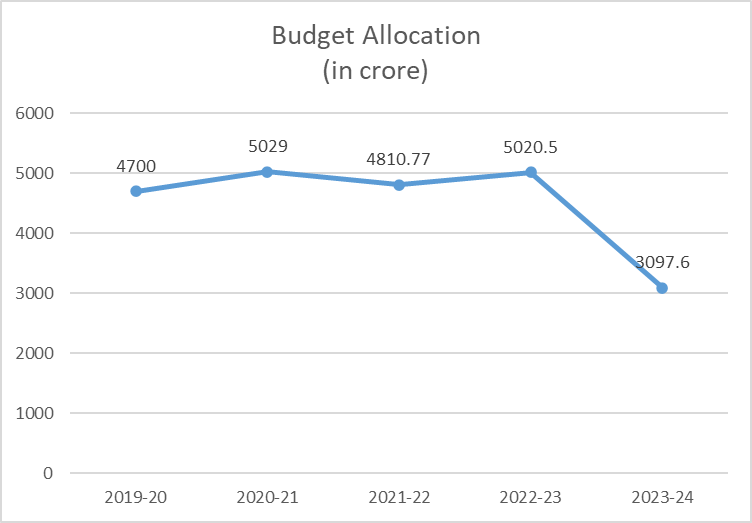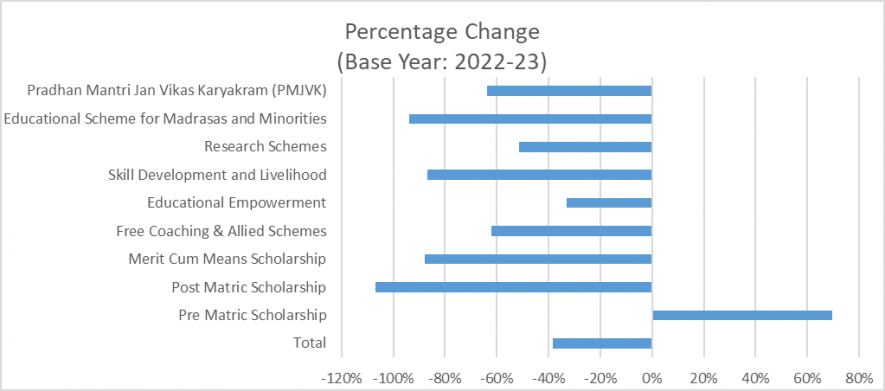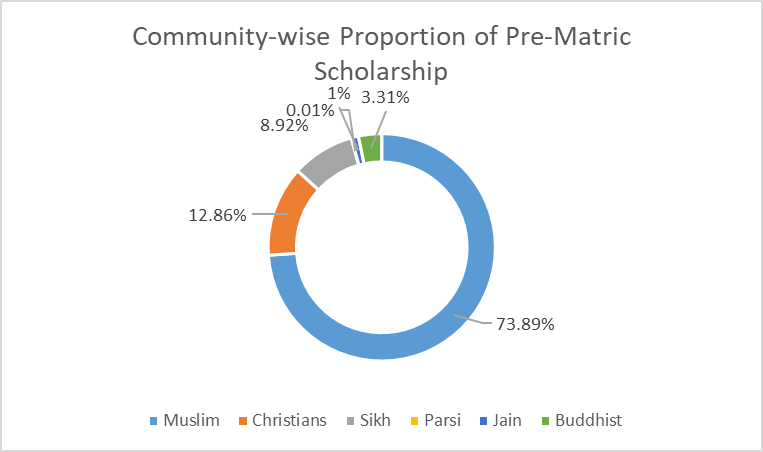Budget 2023-24: Cutting Out Minority Funds or Cutting Out Minorities?

Image Courtesy: Flickr
The Union Budget this year was presented amidst many expectations. With several state elections around the corner and the nation going into general elections next year, experts were looking forward to a Budget that would be pro-people. Given the difficult position that the government was placed in due to the Hindenburg report on Adani and the allegations against government agencies aiding the Adani enterprises, it was only logical to expect a Budget that was popular and inclusive. However, the finance minister surprised everyone once again.
While the Budget for the financial year 2023-24 was presented as the first budget of ‘Amrit Kaal’, it saw several popular programmes such as the Mahatma Gandhi National Rural Employment Guarantee Act (MGNREGA), subsidies, and pensions get massive cuts. Among these, a particular topic of interest is that of minority schemes.
The allocation to the Ministry of Minority Affairs saw a fall from Rs 5020.50 crore in 2022-23 to Rs 3097 crore, a whopping 38% slashed. Considering that the revised estimate of the 2022-23 budget was Rs 2612.66 crores, a fall of 47.9% from the original budget allocation for the financial year, how much of the allocated fund for the year would be utilised for the benefit of the minorities of the country is another topic to ponder.

Graph 1: Budget Allocation for the Ministry of Minority Affairs
The fall in budget allocation for education and skill development of minorities is particularly worrisome. The pre-matric scholarship for minorities saw a cut of about Rs 900 crore, a percentage fall of 69.6, while the merit-cum-means scholarship was cut by about 88%. The support for minority students who cleared the preliminary examinations of UPSC, SSC, and the state PSCs got nothing, while the allocation last year was Rs 8 crore. The allocation for free coaching and allied schemes for minorities and educational empowerment of minorities fell by 62% and 32.8% respectively. The fall in skill development and livelihood was a massive 86.8%, from Rs 491 crore in 2022-23 to Rs 64.4 crore in 2023-24. The allocation for educational schemes for Madrasas and Minorities was cut by 93% in total. The Maulana Azad National Fellowship (MANF) that provided financial support to research scholars from minority communities was discontinued in 2022.

Chart 1: Percentage Change in Budget Allocation for Selected Items (Base Year: 2022-23)
According to the National Scholarship Portal, out of the various scholarships disbursed for the academic year 2021-22, Muslims were the largest beneficiaries at 71%, followed by Christians and Hindus accounting for 9.8% and 9.2% respectively. Interestingly, female students exceeded male students in the beneficiary list of the Pre Matric and Post Matric scholarships, pointing towards an important gender aspect in education for minorities and backward communities. Furthermore, Uttar Pradesh was the largest beneficiary of the Pre-Matric Scholarship with 827248 students availing it, accounting for about 14.65% of the scholarship. This was followed by Maharashtra (14.03%) and Kerala (11.19%).

Graph 2: Community-wise proportion of Pre-Matric Scholarship for the year 2021-22
While the move can be attempted to be justified with fiscal principles and the existence of other larger umbrella schemes for education and skill development, the exclusion of minorities from public spending, especially in education and livelihood training, cannot be seen as an odd and prudent economic decision, but a larger political and social decision.
Exclusion in Progress with Systematic Othering
The Ministry of Minority Affairs identifies Muslim, Christian, Buddhist, Sikh, Parsis and Jain communities as the minority communities. Among these, the othering of Muslims has been executed in multiple stages at various arenas in the country. Lynchings in the name of possession of beef became common in several parts of the country. Muslim existence in itself was questioned in several instances. The COVID-19 pandemic in the country was disparately controversial with the pandemic being communalised by blaming the Tablighi Jamaat that was held in early March 2020 as the superspreader of the pandemic. The unprepared shock of a lockdown announced mere hours in advance, the plight of the migrant labourers, and the unpreparedness of the government in dealing with the pandemic were often covered up by WhatsApp forwards and media propagation of anti-Muslim content. Reducing the significant population of the country to second-grade citizens became the new norm in the country.
The latest in line of Muslim otherings was the “hijab” debate initiated in public educational institutions in Karnataka and later spread to other states. The managements of several institutions denied entry to Muslim students who wore hijab into the campus, citing the dress code that ought to be followed. While several of these institutions did not have such rules specifically in place earlier, the sudden exclusion of women from these institutions had a considerable impact on their education and future. A report on the same suggested that about 50% of Muslim students dropped out of educational institutions due to the hijab controversy. An already side-lined and vulnerable community of Muslim women was further denied the opportunity at education and a career by the State itself, going against the very ethos of democracy and development.
The recently published All India Survey on Higher Education (AISHE) report for 2020-21 found that the proportion of Muslim students enrolling for higher education dropped from 5.5% in 2019-20 to 4.6% in 2020-21, a fall of about 2 lakh students in absolute numbers. While states such as Telangana, Kerala, and West Bengal saw a rise in Muslim student enrolment, a significant fall was reported from almost all other states, with Uttar Pradesh recording the highest fall at 16.3%. The sharp decline in enrolment of Muslim students comes at a time when there has been a 7.5% increase in student enrolment across the country during the period. Clearly, whatever is working well in general is not being reflected in the lives of minorities, especially Muslims. Further cuts in financial benefits and schemes for minority students will have a long-lasting negative impact on their lives.
The ruling Bharatiya Janata Party has its parental organisation founded on the principles of “Hindutva” which ultimately aims to build a Hindu nation. Any person that does not fit into their idea of the Hindu fold is considered an “other” that needs to be converted or eliminated so as to be triumphant in their ultimate goal. Leaving one’s judgement to join the dots, the vilification of Muslims has been following a very systematic and logical path over the years. The rewriting of history where Muslim rulers of the regions that are now parts of India are termed barbarians and enemies of the country is one such instance. The false narratives and propaganda against Muslims at large criticising their food, culture, and livelihood all seem to fit the larger plan. The call for genocide of Muslims has become a common sight in modern India, even from elected MPs.
The othering in modern India is not limited to Muslims alone, but Dalits, Adivasis and other minority groups including Christians. While caste atrocities against Dalits have been brought to international light over the years, the attacks on Christian missionaries accusing them of forced religious conversions have seen a rise of late. Right-wing Hindu outfits have been unleashing violence against converted Christians including tribals, evidenced by the latest stories emerging from Chhattisgarh. Several states have proposed to implement anti-conversion laws to prevent religious conversions. Romantic relationships and marriages involving Muslim men have been termed “Love Jihad”, a baseless allegation that not only questions Muslim men’s integrity but also the women’s agency and choices.
The controversial two-part documentary series published by the BBC earlier this month brought the attention of the international community to the systematic othering of Muslims by the largest political party in the country. The documentary explores the events from the Gujarat riots of 2002 to the lynchings and anti-CAA protests of late 2019 and early 2020. While the first part of the documentary portrayed the pride that people from the Hindu right-wing organisations took in the inhumane and violent acts that they performed against Muslims in 2002, the second shows how we, as a collective people, have become mute spectators in the increasing acts of violence against Muslims. The documentary was not only an accusation against the ruling party and its leaders but also a reality check on the kind of violent and apathetic society that we have become.
Almost all reports on poverty and inequality featuring the country’s demography have placed the Muslim population among the most vulnerable groups, alongside the Scheduled Castes and the Scheduled Tribes. Every call for boycotting Muslim livelihood by the right wing in the country not only affects the monetary income of the community, but also the qualitative development indicators of the people, including children. Being denied economic opportunities, the children from these families being the most vulnerable are left with no option, but to get into early labour. Denied opportunities in education will ultimately reflect in the functioning and capability expansion of the community, thereby creating a wider ridge between the privileged and the minorities. While India is cutting down financial aid for the marginalised and is eagerly awaiting foreign universities to set up campuses here, the accessibility to these institutions and the resulting social and economic divide are quite predictable. It should also not go unnoticed that Muslims are only the first in the many that the several arms of a majoritarian political outfit are aiming to decimate.
The 2023-24 budget is the recent nail in the coffin of Indian secularism and inclusionary development. It will push the minority community away from education and economic opportunities, making them all the more vulnerable in a deeply polarising country. Any chance at survival and bettering their lives is denied to them by the State, ironically, especially at a time when India is celebrating itself as the ‘Mother of Democracy’.
The writer is an independent journalist. The views are personal.
Get the latest reports & analysis with people's perspective on Protests, movements & deep analytical videos, discussions of the current affairs in your Telegram app. Subscribe to NewsClick's Telegram channel & get Real-Time updates on stories, as they get published on our website.
























